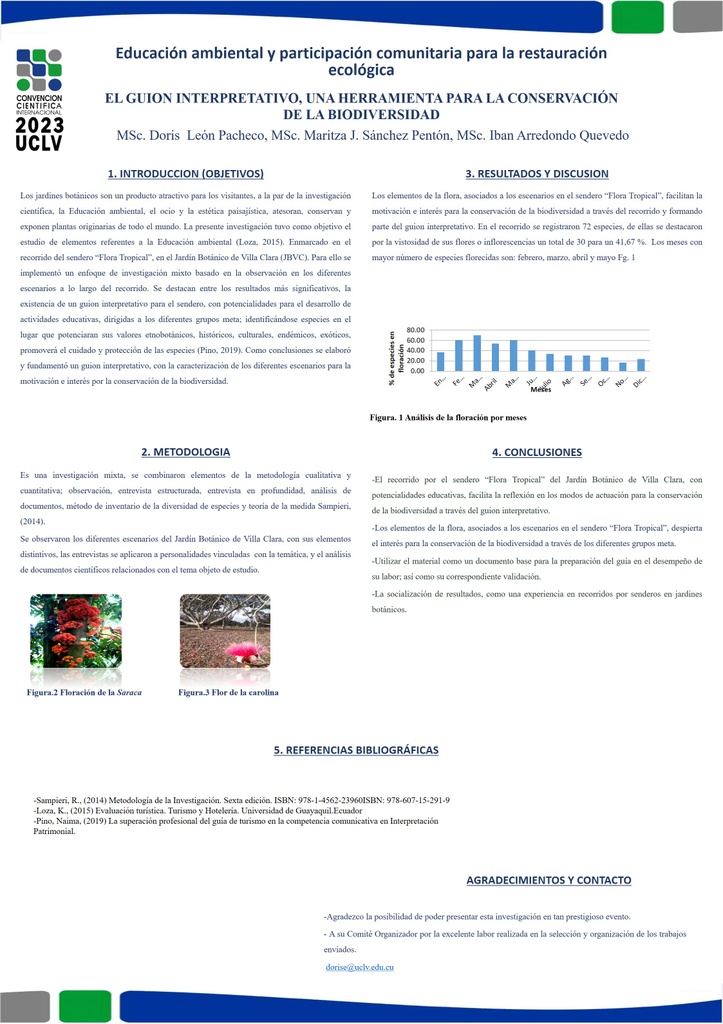Executive Secretary

IX Conferencia Científica Internacional sobre Desarrollo Agropecuario y Sostenibilidad
V Simposio de Restauración ecológica

Resumen
Los jardines botánicos son un producto interesante para atraer a los diferentes grupos meta, a la par de la investigación científica, la Educación Ambiental, el ocio, y la estética paisajística, ellos atesoran, conservan y exponen plantas originarias de todo el mundo. Son instituciones que permiten fortalecer la relación del ser humano con el mundo natural. La presente investigación tuvo como objetivo el estudio de elementos referentes a la Educación Ambiental enmarcados en el recorrido del sendero “Flora Tropical”, en el Jardín Botánico de Villa Clara (JBVC). Para ello se implementó un guion interpretativo que facilitó el desarrollo de actividades educativas a través de la identificación de las especies carismáticas de la flora y la fauna autóctona de Cuba, sus valores etnobotánicos, históricos, culturales, especies exóticas e invasoras, destacando las especies endémicas y los mensajes que se desea transmitir, con la definición muy clara del tema interpretativo que corresponde a cada una de las paradas o sitios de interés. La investigación tiene un enfoque mixto basada en la observación en los diferentes escenarios a lo largo del recorrido, se realizó una búsqueda en la literatura científica especializada actualizada, el análisis de documentos de archivo, entrevistas, encuestas. Como conclusión, los elementos de la flora y la fauna, asociados a los escenarios en el sendero “Flora Tropical”, permiten la fundamentación del guion interpretativo; esto facilita la motivación, reflexión e interés para la conservación de la biodiversidad y proporciona las herramientas metodológicas necesarias para realizar actividades a lo largo del recorrido del sendero.
Abstract
Botanical gardens are an interesting product to attract different target groups, along with scientific research, Environmental Education, leisure, and landscape aesthetics, they treasure, conserve and exhibit plants originating from all over the world. They are institutions that allow us to strengthen the relationship between human beings and the natural world. The objective of this research was to study elements related to Environmental Education framed in the route of the “Tropical Flora” trail, in the Botanical Garden of Villa Clara (JBVC). For this, an interpretive script was implemented that facilitated the development of educational activities through the identification of the charismatic species of the native flora and fauna of Cuba, their ethnobotanical, historical, cultural values, exotic and invasive species, highlighting endemic species and the messages that you want to transmit, with a very clear definition of the interpretive theme that corresponds to each of the stops or places of interest. The research has a mixed approach based on observation in the different scenarios along the route, a search was carried out in the updated specialized scientific literature, the analysis of archival documents, interviews, surveys. In conclusion, the elements of flora and fauna, associated with the scenarios on the “Tropical Flora” trail, allow the foundation of the interpretive script; this facilitates motivation, reflection and interest in the conservation of biodiversity and provides the necessary methodological tools to carry out activities along the route of the trail.
Sobre el ponente

Doris Leon Pacheco

Discussion

